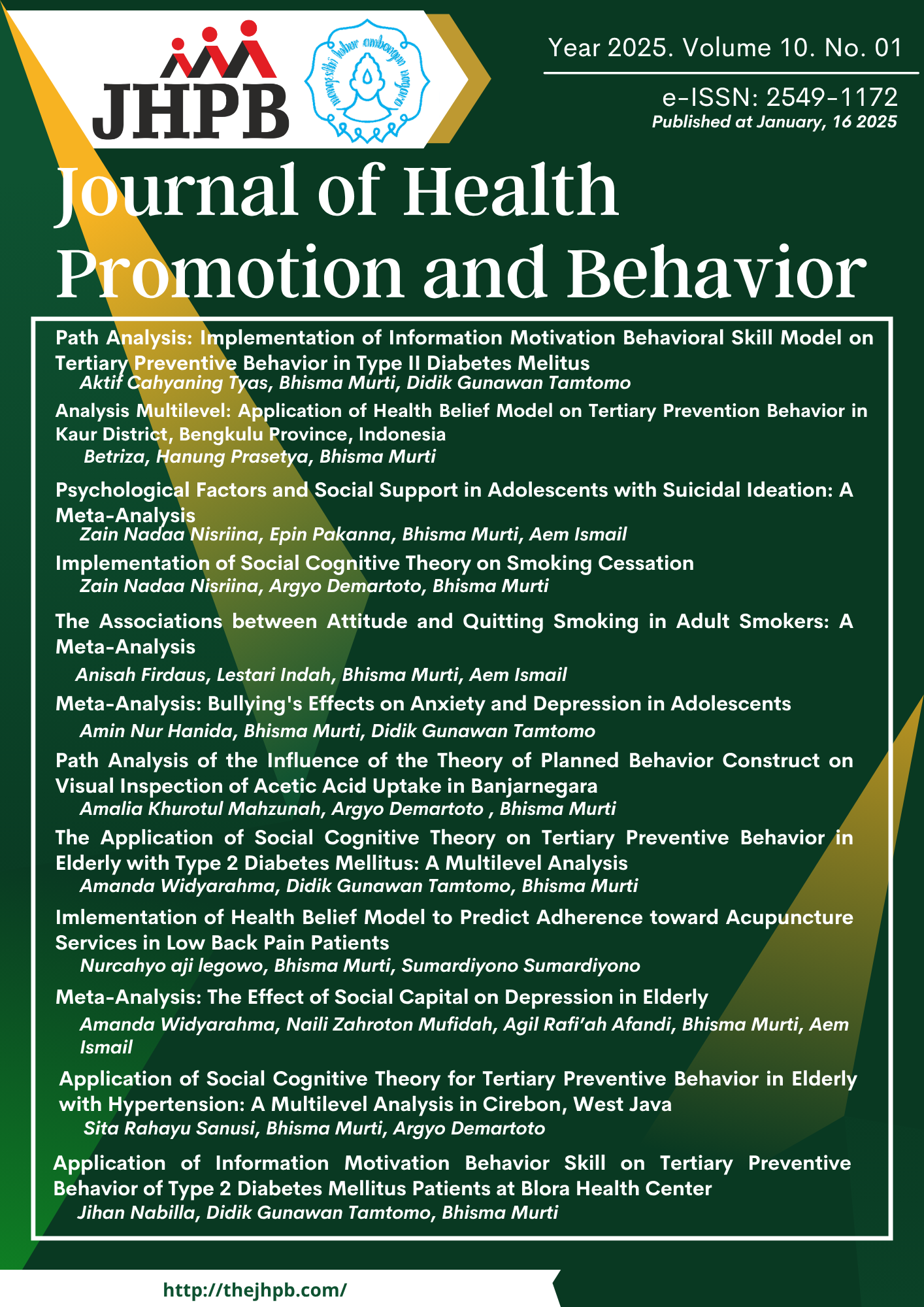Path Analysis of the Influence of the Theory of Planned Behavior Construct on Visual Inspection of Acetic Acid Uptake in Banjarnegara
DOI:
https://doi.org/10.26911/thejhpb.2025.10.01.07Abstract
Background: The death rate for women of childbearing age is increasing. This indicates the need for useful interventions to prevent deaths from cervical cancer. One way is to carry out an Acetic Acid Visual Inspection (VIA) screening. Unfortunately, the rate of VIA screening is still low. So it is necessary to conduct research on how the behavior of using VIA screening is viewed from health promotion theory. This study aimed to determine the application of one of the health promotion theories, namely the Theory of Planned Behavior (TPB), to the use of VIA screening in Banjarnegara Regency.
Subjects and Method: The study was conducted with a cross-sectional study design involving 200 female participants of reproductive age ranging from 20 to 50 years. This research was conducted in Banjarnegara Regency, Central Java Province, Indonesia. This study was conducted in April-May 2024. The sample was selected using fixed disease sampling to find participants who had undergone VIA screening. Data collection was carried out using questionnaires and data was analyzed using univariate, bivariate and path analysis.
Results: The results of this study showed that the behavior of using VIA screening was directly influenced by intentions and perceived behavioral control. The possibility of subjects to undergo VIA screening can increase by strong intentions (OR= 6.56; 95% CI= 2.97 to 14.48; p< 0.001) and high perceived behavioral control (OR= 6.23; 95% CI= 3.07 to 12.65; p < 0.001). In addition, the results of path analysis showed that intentions were influenced by attitudes (OR= 2.73; 95% CI= 1.31 to 5.69; p= 0.007), subjective norms (OR= 3.48; 95% CI= 1.71 to 7.07; p= 0.001), and perceived control treatment (OR= 3.03; 95% CI= 1.50 to 6.09; p= 0.002).
Conclusion: The use of VIA screening is directly influenced by intention and perceived behavioral control. In addition, intentions are influenced by attitudes, subjective norms, and perceived behavioral control. All results of the analysis are statistically significant.
Keywords:
theory of planned behavior, cervical cancer screening, women of reproductive age.How to Cite
References
Alemnew W, Debalkie G, & Azale T. (2020). Intention to screen for cervical cancer among child bearing age women in Bahir Dar City, North-West Ethiopia: Using Theory of Planned Behavior. Int J Women’s Health. 12(1): 1215–1222. Doi: 10.2147/IJWH.S277441
An J, Vincent C. (2022). A Critique of the theory of lanned behavior in the cancer screening domain. ANS. 45(2): 179–193. Doi: 10.1097/ANS.0000000-000000395
Asare M, Lanning BA, Montealegre JR, Akowuah E, Adunlin G, & Rose T. (2023). Determinants of low-income women’s participation in self-collected samples for cervical cancer detection: Application of the Theory of Planned Behavior. CHERP. 44(1): 65–76. Doi:10.1177/0272684X221090060
Ba D, Ssentongo P, Musa J, Agbese E, Diakite B, Traore C, Wang S, & Maiga M (2021). Prevalence and determi-nants of cervical cancer screening in five sub-Saharan African countries: A population-based study. Cancer Epi-demiol. 72(2): 25–32. Doi: 10.1016/j.c-anep.2021.101930
Barbera F, Ajzen I (2020). Control inte-ractions in the theory of planned behavior: Rethinking the role of sub-jective norm. Eur J Psychol. 16(3): 401–417. Doi: 10.5964/ejop.v16i3.20-56
Chouksey N, Mishra GC, Chouksey R. (2020). Path analysis in rice yield and yield attributing characters by struc-tural equation model. IJMAS. 9(5): 3098–3103. Doi: 10.20546/ijcmas.20-20.905.367
Conner M, Norman P (2022). Under-standing the intention-behavior gap: The role of intention strength. Front Psychol. 13(1): 1–16. Doi: 10.3389/-fpsyg.2022.923464
Destriani S, Maryani D, Himalaya D. (2022). Faktor-faktor yang behu-bungan dengan perilaku pemeriksaan Inspeksi Visual Asam Asetat (IVA) pada wanita usia subur di Puskesmas Kemumu. JMWH. 10(2): 137–141. Doi: 10.37676/jm.v10i2.3269
Dsouza J, Broucke S, Van D, Pattanshetty S, Dhoore W (2022). A comparison of behavioural models explaining cervi-cal cancer screening uptake. BMC Women’s Health. 22(1): 1–14. Doi: 10.1186/s12905-022-01801-2
Enyan N, Davies A, Opoku-Danso R, Annor F, Obiri-Yeboah D (2022). Correlates of cervical cancer screening partici-pation, intention and self-efficacy among Muslim women in southern Ghana. BMC Women’s Health. 22(1): 1–11. Doi: 10.1186/s12905-022-01803-0
Eshetu HB, Shitu K, Handebo S (2022). Predictors of intention to receive cer-vical cancer screening among com-mercial sex workers in Gondar city, northwest Ethiopia: application of the theory of planned behavior. BMC Women’s Health. 22(1): 462. Doi: 10.1186/s12905-022-02055-8
Getahun T, Kaba M, Derseh BT (2020). Intention to Screen for Cervical Can-cer in Debre Berhan Town, Amhara Regional State, Ethiopia: Application of Theory of Planned Behavior. J Cancer Epidemiol. 20(2): 1-10. Doi: 10.1155/2020/3024578
Hardin F & Ricks JM. (2017). Attitudes, social norms and perceived behavioral control factors influencing participation in a cooking skills program in rural Central Appalachia. Glob Health Promot. 24(4): 43–52. Doi: 10.1177/1757975916636792
Heidari SM, Khani JA, Moradi Z, Dehghan A (2021). Evaluating the effect of an educational program on increasing cervical cancer screening behavior among women in Fasa, Iran. BMC Women’s Health. 21(1): 41. Doi: 10.-1186/s12905-021-01191-x
Ilevbare O, Adegoke AA, Adelowo CM (2020a). Drivers of cervical cancer screening uptake in Ibadan, Nigeria. Heliyon. 6(3): 1–13. Doi: 10.1016/j.-heliyon.2020.e03505
Jha S, Dobe M, Taklikar C, Lahiri A (2022). Perceived behavioral control regard-ing regular physical activity and healthy diet: An observational study among school-going adolescents in an urban area of West Bengal, India. J Educ Health Promot. 11(1): 261. Doi: 10.4103/jehp.jehp_1414_21
Khani A, Jormand H, Harsini PA (2021). The effect of educational program based on beliefs, subjective norms and perceived behavior control on doing pap-smear test in sample of Iranian women. BMC Women’s Health. 21(1): 290. Doi: 10.1186/-s12905-021-01419-w
Kiriakidis S (2017). Perceived Behavioural Control in the Theory of Planned Behaviour: Variability of Conceptua-lization and Operationalization and Implications for Measurement. In Stategic Innovative Marketing (1st ed., pp. 197–202). Doi: 10.1007/978-3-319-33865-1_25
Komalawati G, Martha E (2023). Factors that influence the behavior of women of childbearing age for early detection of cervical cancer through IVA tests in Indonesia: Literature review. J Soc Sci Res. 2(11): 4123–4129. Doi: 10.55-324/josr.v2i11.1566
Leong E, Ong SK, Si-Ramlee K, Naing L (2023). Cancer incidence and morta-lity in Brunei Darussalam, 2011 to 2020. BMC Cancer. 23(1): 466-476. Doi: 10.1186/s12885-023-10962-8
Li X, Dai J, Zhu X, Li J, He J, Huang Y, Liu X, et al. (2023). Mechanism of atti-tude, subjective norms, and perceived behavioral control influence the green development behavior of construction enterprises. Humanit Soc Sci. 10(1): 266. Doi: 10.1057/s41599-023-01724-9
Ningrum M (2019). Persepsi wanita usia subur tentang pemeriksaan Inspeksi Visual Asetat (IVA). JIK Akbiduk. 8(1): 8–15.
Nurramadhani E, Novani D, Amelia FN, Nisa H (2022). Intention towards the early detection of cervical cancer up-take among university students. Al-Sihah. 14(1): 25–37. Doi: 10.24252/al-sihah.v14i1.27068
Rafi’ah, Tualeka AR, Widajati N (2018). A correlation analysis of attitude, sub-jective norm and behavioral control toward the intention of safety beha-vior: (A study on plate cutting workers of commercial ships division PT. PAL Indonesia (Persero). IJPHRD. 9(5): 137. Doi: 10.5958/0976-5506.2018.-00426.6
Rajeh MT (2022). Modeling the theory of planned behavior to predict adults’ intentions to improve oral health beh-aviors. BMC Public Health. 22(1): 1391. Doi: 10.1186/s12889-022-13796-4
Rakic T, Zivkovic S (2017). Hierarchy of needs and correlation connections as an important element of successful employees’ motivation. Ekonomika. 63(4): 61–73. Doi: 10.5937/ekono-mika1704061R
Sary YNE, Ekasari T, Rohmatin H, Ermawati I (2023). Deteksi dini kanker serviks dengan Inspeksi Visual Asam (IVA). JPMN. 3(2): 66–72.
Wang X, Cheng Z (2020). Cross-sectional studies. Chest. 158(1): 65–71. Doi: 10.1016/j.chest.2020.03.012
Wooldredge J (2021). Path Analysis. J Crim Justice. 2(5): 515–522. Doi: 10.-1002/9781119111931.ch105.
Xin T, Jiang Y, Li C, Ding X, Zhu Z, Chen X (2023). Using planned behavior theory to understand cervical cancer screening intentions in Chinese women. Front Public Health. 11(1): 1–8. Doi: 10.3389/fpubh.2023.1063694





